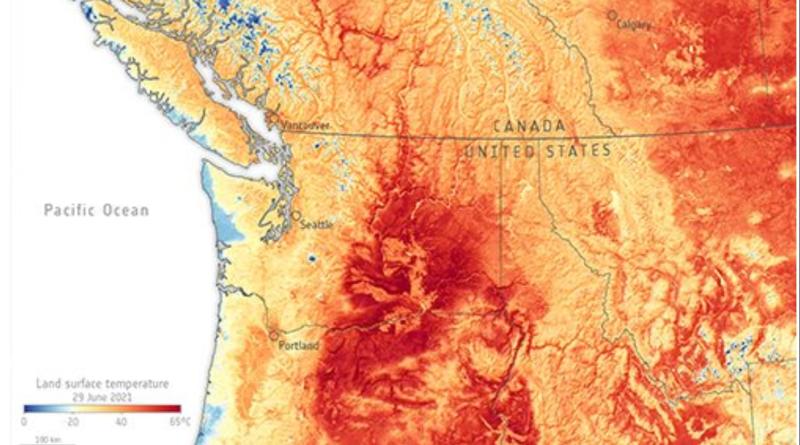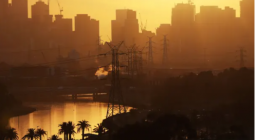‘Silent Killer’: Canadian Cities Scramble to Prevent Heat-Related Deaths

As Canadians accustomed to layering up and buckling down for the winter now confront the challenge of lethal heatwaves, how are municipalities readying their residents and infrastructure for this “silent killer?”
Extreme heat is a silent killer, and it’s invisible. And that explains why it’s “a weather hazard that is under-appreciated,” Caroline Metz, managing director, economics and resiliency at the University of Waterloo’s Intact Centre on Climate Adaptation, told The Energy Mix.
“We don’t see the same physical damage to buildings and properties that we do with floods and wildfires, but extreme heat is dangerous for our health,” she added. “It’s responsible for more illness and deaths than most other extreme weather hazards combined.”
Heat-Related Deaths Are Preventable
Proactive measures to protect people well before a heat wave are important, Metz said, because illness and death from heat are largely preventable. To that end, Metz is leading the development of a new heat resilience tool to help municipalities assess and address their heat risk.
When cities act to protect their most vulnerable residents, the reward is long-term community sustainability. “Extreme heat is not experienced the same by all residents of a city or community,” she said. “It draws a distinction between the secure and those made vulnerable by factors like age, income, pre-existing health conditions, housing status, and social isolation.”
Residents of British Columbia experienced that reality when the blistering heat dome of 2021 killed 619 people in the province. A review found that most people who died were elderly, had a disability, lived in poorer neighbourhoods, or lived alone.
In a 2023 investigation, CBC News found that many Canadians are unsafe in their own homes each summer, with indoor temperatures consistently exceeding the safe maximum of 26°C. The investigation revealed an urgent need to cool a housing stock that wasn’t built for today’s warmer climate, CBC said.
A year earlier, the Intact Centre released [pdf] an extensive report on how to protect Canadians from “a lethal future” of extreme heat. The report laid out the health, infrastructure, ecological, and economic risks and recommended 35 actions for resilience.
Those solutions fall broadly into three types, the Centre said, beginning with non-structural planning and behavioural changes like neighbour check-ins, learning to use natural ventilation, and that public heat warnings reach their intended audiences. Then come green infrastructure applications like shade trees and green roofs. And third, design changes and retrofits for built, or “grey” infrastructure. The Intact Centre stressed that building efficiency must be prioritized, explaining that a well-insulated building is a cool one in summer. Other grey infrastructure shifts include reflective roofs and shade fittings like awnings, shutters, and window blinds.
The Intact Centre report urged Canadian policy-makers to take swift action to address extreme heat risks, but two years later, much remains to be done, said Joanna Eyquem, Centre’s managing director, climate-resilient infrastructure.
“In terms of communicating the natural hazard and risks of heat waves, extreme heat is still not given the urgent attention required in Canada,” Eyquem told The Mix, adding that extreme heat “is not even mentioned” on the federal government’s natural hazards website.
Ottawa has also failed to connect energy efficiency with heat resilience in its residential climate resilience recommendations to the public, Eyquem added. that is “particularly an omission, as many extreme heat actions also benefit energy efficiency.” Such gaps will not help Canada meet the target pledge, embedded in its 2022 National Adaptation Strategy, to “eliminate” extreme heat wave deaths by 2040, she said.
Lethal Heat Prompts ‘Equity-Based Approach’
At the municipal level, integrated efforts to protect residents from extreme heat are uncommon, with systemic action undertaken only in the aftermath of a lethal heat event, Eyquem said, citing Montreal’s response to the 2018 heat wave that left 70 dead, 80% of them in their own homes.
Montreal integrated heat into many aspects of its climate plan, with a vision that by 2030, heat islands in all its neighbourhoods [map] will nearly disappear thanks to a burgeoning tree canopy. Meanwhile, Montreal’s cooling resource map launched last spring helps residents locate nearby splash-pads, air-conditioned spaces, pools, or misting stations.
Metro Vancouver became proactive in its response to extreme heat after the heat dome killed 434 residents. Its report on community-led heat resilience, published [pdf] in March 2023, analyzed lessons from that deadly event. It found that a decade of planning and city-led actions to mitigate and respond to heat—actions similar to Montreal’s cooling centres and drinking fountains—fell short in the face of extreme heat that year.
Vancouver’s experts recommended an equity-based approach to extreme heat planning, with a focus on seniors and people with disabilities who must be able to cool in place. The spatial inequalities between neighbourhoods—like fewer trees or older buildings—must be factored in, and all planning must involve community partners to reach into and support equity-denied groups. From these ideas, Vancouver developed the Resilient Neighbourhoods Program, which supports 15 community organizations to “build neighbourhood capacity to collectively prepare for, respond to, and recover from extreme heat and other emergencies.”
Province-wide, British Columbians have a 16-page extreme heat preparedness guide [pdf] with tips on staying cool and recognizing the symptoms of heat stroke. The provincial telehealth service HealthLinkBC also provides detailed information on how to “beat the heat,” offered in English and several other languages.
Canada’s Top Ten Warmest CIties
The Intact Centre identified the “Top 10” Canadian municipalities projected to have the greatest number of very hot days (30°C+), the warmest maximum temperatures, and longest heatwaves between 2051 and 2080. Toronto, Ottawa, Lethbridge, Hamilton, Kelowna, and Windsor broke the top ten in all three categories. The Mix reached out to all of them for comment.
Toronto Boosts Green Cover
In Toronto, the number of very hot days is expected to triple even in a low-carbon scenario, while the length of a heatwave will double. Staffers say the city has launched multiple initiatives to maintain and increase cooling green spaces, including its 2010 Green Standard, which sets sustainable design and performance requirements for new private and city-owned developments.
“Minimum performance measures include requirements for onsite green infrastructure, such as adding green roof coverage, greening streets, planting large shade trees, treating 75% of the non-roof hardscape to reduce the urban heat island effect, and green or cool roofs,” said Toronto’s senior communications advisor, media relations and issues management, Laura McQuillan. The standard was launched a year after Toronto became the first city in North America to mandate green roof coverage (between 20 and 60% of available roof space) on all new builds with at least 2,000 square-metres of floor area.
McQuillan added that Toronto’s ravine, biodiversity, and parkland strategies come with in-built cooling effects, as they seek to protect and expand the city’s green spaces. (As yet, none of these strategies have had their front matter updated to link a green Toronto with a cool one.)
Asked whether Toronto knows where its hottest spots are, and where its most heat-vulnerable people live, McQuillan pointed to vulnerability mapping conducted by Toronto Public Health in 2011, adding that recent University of Toronto research found that “the overall patterns of heat exposure and vulnerability have not significantly changed.”
The city’s heat relief strategy, which includes a mapped heat relief network of more than 400 cool spaces across the city, serves to protect vulnerable residents from extreme heat, McQuillan said. Some of these cool spaces run all day and night to support people who are unhoused. Those on the streets receive further assistance from outreach services during heat warnings.
The City reminds Torontonians to check up on vulnerable family, friends, and neighbours to make sure they keep hydrated and cool during heatwaves. And Toronto’s RentSafeTO program has heat protection provisions, requiring landlords and property owners to create a hot weather plan for protecting tenants from heat-related illness. Tenants must also have access to information on air conditioned or cool locations under Toronto’s Apartment Buildings Bylaw.
Toronto is also pursuing a partnership with the C40 Cities leadership group, with city staff “currently working to identify new options and opportunities for addressing high indoor temperatures,” McQuillan said.
A study on thermal comfort, potentially mandating resilient outdoor space design for large buildings, and a green streets study to enhance tree canopy, particularly in hotter urban areas, are two initiatives in the works to help limit the urban heat island effect, said Toronto’s program manager, urban design, city planning, Kristina Reinders.
Lethbridge Cites Extreme Heat as ‘Critical Climate Risk’
Lethbridge, Alberta, has an Extreme Temperature Response Protocol to be enacted during extreme temperature events like prolonged heatwaves, said sustainability engineer Raene Barber. Its purpose is to provide an informed, coordinated community response that is attuned to high-risk populations.
As well, the city’s Climate Adaptation Strategy and Action Plan, in its final stages of development, will “recognize that extreme heat is a critical climate risk to Lethbridge, and that municipal action can help lessen the impacts to residents,” Barber added.
She said the plan was developed in consultation with groups like Alberta Health Services, Lethbridge Senior Citizens Organization, and Lethbridge Housing Authority.
Barber added that Lethbridge’s urban tree canopy, park space, and natural environment will play a key role in minimizing risks of extreme heat. “Green infrastructure and naturalization of park spaces are important considerations for the future.” As examples, she cited the 2021 conversion of 11,250 square metres of irrigated park space within the city to naturalized grasslands and the living roof at the Helen Schuler Nature Centre.
Hamilton Updates its Heat Strategy
The City of Hamilton made headlines last May whena public health committee unanimously approved councillor Cameron Kroetsch’s motion to develop a bylaw that would require landlords to install air conditioning in apartments to keep temperatures below 26°C. As of January, council debate on the measure was still under way.
A new report on Hamilton’s heat response strategy is slated for April 29, and the document is available for preview online.
Hamilton’s director of climate change initiatives, Lynda Lukasik, cited the city’s Climate Change Impact Adaptation Plan as the wider context for its heat strategy. The adaptation plan “sets out a number of essential actions to address community impacts from extreme heat,” with the heat response strategy as the implementation tool.
“Many of these actions are shorter term,” Lukasik said, while examples of longer-term actions—found in the climate mitigation plan—include increasing urban forest cover, retrofitting existing buildings, and putting up more efficient new buildings with low- or no-carbon heating and cooling facilities.
Canada’s Capital Gathers Data
Ottawa Public Health (OPH) is working on its first-ever Climate Change Health Vulnerability Assessment (CCHVA) on extreme heat, scheduled for completion by the end of this year. Additional vulnerability assessments on vector-borne disease, food- and water-borne illness, wildfire smoke, and stratospheric ozone will follow.
OPH, the city, and community partners like Outreach Services and Ottawa Community Housing “will use the findings of the CCHVA to scope, advocate for and, where possible, implement new and enhanced extreme heat adaptive strategies and share protective strategies and resources on how to prevent heat-related illnesses and deaths,” wrote [pdf] Medical Officer of Health Dr. Vera Etches in an October, 2023 memo.
Figuring out how to maximize extreme heat protection for all residents has a central place in Ottawa’s official climate resilience strategy. The draft document, titled Climate Ready Ottawa, is out for public consultation, with a survey closing May 21 and an open house coming up.
The city has announced no recent heat-specific infrastructure or regulatory changes, but its 2020 Climate Change Master Plan identifies green infrastructure as a priority focus for exploration through 2025. The Climate Ready Ottawa survey asks residents whether advocating for changes to the National Building Code to promote resilience should be a priority city action.
Kelowna in the Cross-Hairs: Lessons Learned from Heat Dome
The Intact Centre report puts Kelowna in the top ten of Canadian cities at risk of extreme heat out to 2080, even under low-carbon scenarios. The southern Okanagan city of 166,000 places #1 for both maximum temperature and heat wave duration, and in the top four for very hot days. Even with emissions held down, Kelowna is projected to experience an average of 48 days per year above 30°C by 2080, more or less doubling its historical average.
The city completed a climate vulnerability and risk assessment (CVRA) last year. It found that whereas some 25% of residents are exposed to extreme heat today, 100% will be by 2070. This shift to universal risk will occur even as Kelowna’s population approaches 250,000.
To identify the city’s hot spots, and where its most heat-vulnerable residents live, the CVRA mapped temperature data from the peak of the 2021 heat dome (11 PM on June 29, 2021) over zoning and demographic information,
“We are starting to have a more granular understanding of the localized differences in extreme heat and how that impacts our most vulnerable populations,” Climate Action and Environment Manager Chris Ray told The Mix.
Asked about current protection measures available to the public, Kelowna media spokesperson Marnie Douglas pointed to online resources sharing best practices on keeping cool in the heat, as well as the location of cool public spaces. City staffers also work “collaboratively with outreach workers” to provide comprehensive support for particularly vulnerable people, especially the unhoused, Douglas said.
Windsor, Ontario, which is projected to see its exposure to summer daytime temperatures over 30°C nearly triple by 2080, did not respond to an interview request by the time The Mix went to virtual press Wednesday evening.





